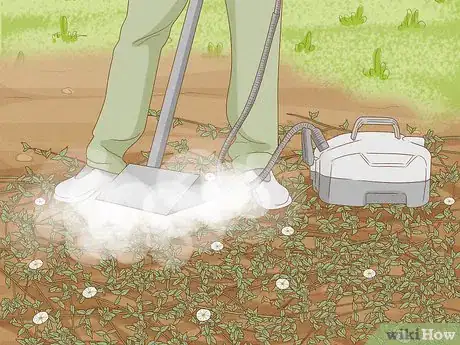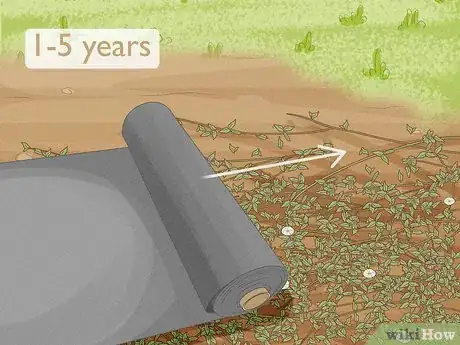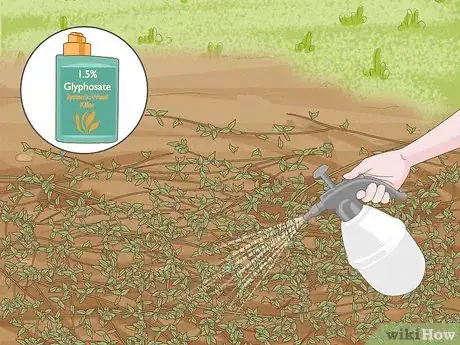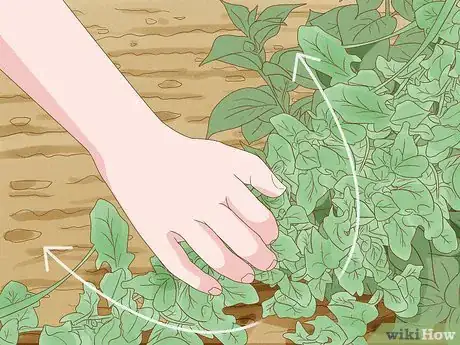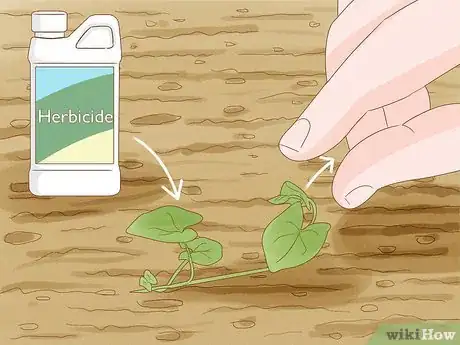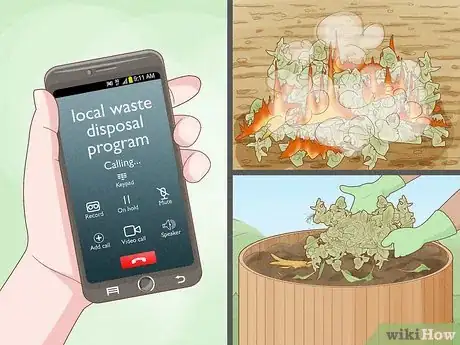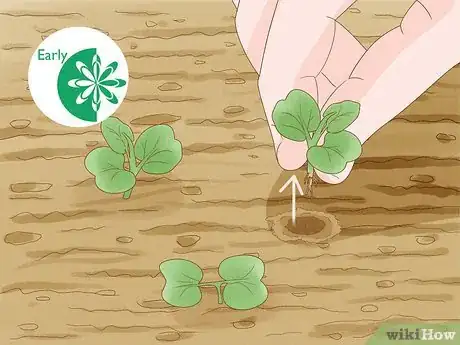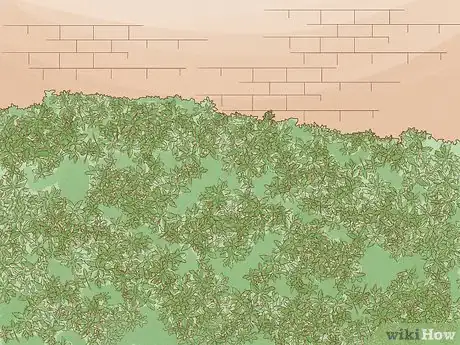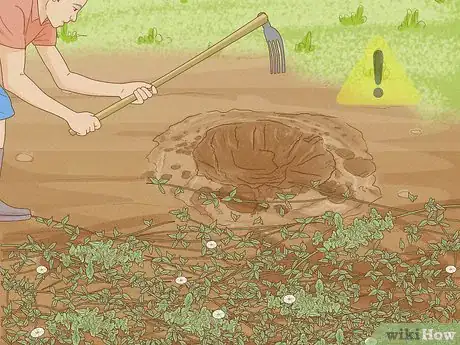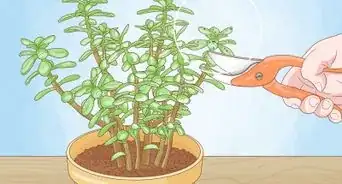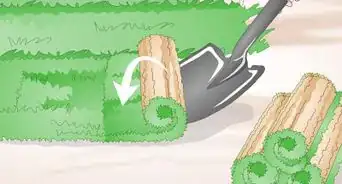This article was co-authored by wikiHow staff writer, Megaera Lorenz, PhD. Megaera Lorenz is an Egyptologist and Writer with over 20 years of experience in public education. In 2017, she graduated with her PhD in Egyptology from The University of Chicago, where she served for several years as a content advisor and program facilitator for the Oriental Institute Museum’s Public Education office. She has also developed and taught Egyptology courses at The University of Chicago and Loyola University Chicago.
There are 19 references cited in this article, which can be found at the bottom of the page.
This article has been viewed 10,975 times.
Learn more...
While some types of morning glories make beautiful and desirable additions to any garden, others are less welcome. One type of plant commonly known as “morning glory” is actually bindweed. This is a very different sort of plant from the pretty purple blooms you might grow from a seed packet. If you’ve noticed these invasive vines with their little white blossoms running wild in your garden or yard, don’t worry—with a bit of persistence, it is possible to get them under control. In this article, we’ll discuss a variety of methods for getting rid of morning glories, including chemical-free techniques.
Steps
Removing Morning Glory
-
1Kill established vines with steam. Steam is a good alternative to chemical herbicides. Farmers sometimes use trailer-mounted steamers to kill vines that are growing over large areas of ground.[1] However, if you’re looking to control morning glories in your yard or garden, you can buy or rent a small weed steamer from a home or garden supply store. Run the steamer over the vine until the leaves turn bright green and begin to wilt.[2]
- A basic steam cleaner may also do the job if you can’t find a weed steamer. Look for a device that can heat the steam up to at least 250 °F (121 °C).[3]
- While agricultural weed steamers cost thousands of dollars, you can get a small garden steamer for $100 USD or less.
- Hot steam kills weeds by exploding the cells within the leaves, preventing the plant from absorbing any more nutrients. You may need to repeat the process later in the growing system if the morning glories return.[4]
-
2Smother ground vines with fabric and mulch for 1-5 years. This chemical-free method is effective, but takes time and patience. Lay some black landscape fabric or plastic over any areas where the morning glories are growing, then pour on a layer of mulch 2–3 inches (5.1–7.6 cm) thick. Since bindweed sends out runners under the ground, cover an area that extends at least 2 feet (0.61 m) beyond where the vines stop. Leave the cover in place for 1-5 years in order to kill off the weeds completely.[5]
- As an alternative to plastic or fabric, you can also lay down overlapping sheets of cardboard over the morning glories, then cover them with mulch. However, since cardboard will eventually degrade, you’ll have to replace it at least once a year.
- Check frequently for areas where the bindweed or morning glory vine has started to push up through the mulch cover. Pull up any stray tendrils or blast them with steam or a herbicide.[6]
Advertisement -
3Use a systemic herbicide for faster results. Make sure you choose a systemic weed killer, such as 1.5% glyphosate. Use the herbicide when the plants are flowering.[7] Spray down the entire plant with a hand-sprayer until it’s wet, but not dripping—you want to avoid getting the herbicide on any surrounding plants.[8] This approach works best when you combine it with other methods, such as pulling up seedlings and covering the plants with mulch.
- Systemic herbicides attack the entire plant, including the roots. You may need to apply the herbicide several times for it to work.
- You can also apply pre-emergent herbicides, such as 2,4-D or dicamba, on the ground in early spring to kill seedlings before they emerge. However, you’ll probably need to combine this method with using systemic herbicides on the mature plants.[9]
- Follow the directions on the package carefully. Cover any other plants nearby that you want to protect from the herbicide. Wear any protective gear recommended on the packaging, such as nitrile gloves and safety goggles.[10]
-
4Skip the vinegar and other homemade herbicides. Most natural herbicides work on contact. That means that they only kill whichever part of the plant they touch.[11] To effectively kill the root systems of morning glories and keep them from growing back, you’ll need something more powerful that is absorbed into the plant’s system and penetrates the roots.[12]
- Other alternative herbicides that unfortunately will not work on morning glories include citric or acetic acid, plant oils (such as clove or lemongrass oil), and household cleansers (such as Borax).
-
5Pull hedge bindweed by hand. This type of morning glory climbs over other plants. While it looks similar to field bindweed, it’s a different kind of vine that tends to climb up over upright structures and plants instead of growing across the ground. The easiest way to get rid of these plants is to carefully unwind them and then pull them up at the roots by hand. Make sure you pull up as much of the root system as possible.[13]
- You may also be able to kill them by unwinding them from around their host plant or structure, and then rewinding them again in the opposite direction.
-
6Combine several methods for the best results. Bindweed is tenacious and hard to control. To get rid of it—and keep it gone—you may need to use several different approaches at once. For instance, a combination of herbicides and hand-pulling is likely to work better than just one or the other alone.[14]
- The best combination of methods may depend on factors like how large the infestation is and what kinds of desirable plants you’re trying to grow in the area.
- For instance, in a garden, you might find it most effective to smother the vines with fabric and mulch for a few years, then replant the area with a decorative groundcover.
- In a larger area, like a yard or field, a combination of tilling and herbicide applications might work best.
-
7Repeat your chosen methods as needed. No matter what method(s) you choose, you’ll need to stay vigilant. Keep looking for new seedlings or vines, and either pull them up or treat them with herbicide whenever you see them.[15]
- It may take a few years of hard work to completely beat back a morning glory infestation.
- Baby plants can regenerate from root fragments in just a few weeks, so check frequently for new growth after treating an area.
-
8Check local regulations for disposing of weeds. Leaving dead weeds in place is often the best approach. Depending on where you live, you may also be able to bag up the morning glory vines after you kill or uproot them and throw them away in the regular trash. However, disposing of noxious weeds (i.e., weeds that are harmful to other plants or the local ecosystem) in the trash isn’t legal everywhere—especially if they’re invasive in your area. If you’re not sure what to do, call your local waste disposal program or check with an agricultural extension office in your area for more information.[16] Other options include:
- Burning the pulled-up morning glory plants.
- Composting any vines that haven’t been treated with pesticides. However, you’ll need to check your compost pile or bin regularly and get rid of any growing seedlings.
- Allowing the weeds to rot thoroughly in a bucket of water before adding them to your compost pile or bin.[17]
Preventing Morning Glory
-
1Hand-pull the seedlings in early spring. Morning glories don’t spread until they’re 3-4 weeks old. To keep new plants from getting established and growing deep roots and runners, carefully watch any areas where morning glories tend to grow. Pull the seedlings out of the soil as soon as you notice them. Be very careful to pull up as much of the roots as you can.[18] Look for seedlings with square, boxy, or kidney-shaped leaflets.[19]
- Once a morning glory vine is established, it will begin to spread and grow an extensive, complicated root system. While you can hand-pull more mature morning glories, you’ll need to keep doing it repeatedly every 2-3 weeks over a period of at least 3 years.[20]
- While mature bindweed roots can grow as deep as 20 feet (6.1 m) under the soil, most of them won’t grow deeper than about 2 feet (0.61 m). However, new plants can easily grow from small root fragments that are left behind.[21]
- If you choose to pull up mature vines, dig deep with a hoe or garden fork and pull out as many of the roots as possible so that they don’t sprout new plants.
-
2Plant a competitive groundcover. This will help keep morning glories from returning. Once you’ve gotten a morning glory infestation under control, the challenge is to keep them from coming back. To do this, plant the area densely with other plants that can crowd out the young seedlings. Some good options include groundcover plants (such as carpet phlox or pachysandra), grasses, or low-growing shrubs.[22]
- After you plant your new ground cover, be vigilant! If you notice new morning glory vines starting to grow among the desirable plants, pull them out as soon as you see them.
-
3Use caution when digging around mature morning glories. Bindweed easily grows from fragments of roots or runners. Be careful digging or tilling in any area where established bindweed is present, since you could accidentally break up the roots and spread them around.[23]
- This can also be a problem when you try to hand-pull morning glory vines. To minimize the risk of spreading live root fragments around, stick to pulling up seedlings instead of mature plants as much as possible.
- While repeatedly hand-pulling mature plants can eventually weaken and kill them, it’s important to dig deep and remove as many of the roots from the ground as possible to keep them from growing back. Use a garden fork or hoe to dig out deep roots.[24]
-
4Install physical barriers to keep morning glories out. Installing an upright barrier under the soil along fences can help keep morning glories from creeping into your property. Buy a vertical weed barrier online or from your local home and garden supply center. Look for a barrier with a depth of at least 18 inches (46 cm).[25]
- For the best results, install the barriers in late winter or early spring, before new morning glories have a chance to get established.[26]
- You can buy prefabricated weed barriers or make your own from materials like fabric, paving slabs, or edging board. These are better options than plastic sheeting, which tends to degrade quickly.
References
- ↑ https://www.canr.msu.edu/foodsystems/uploads/files/fieldbindweed.pdf
- ↑ https://youtu.be/E71TRCQg5us?t=161
- ↑ https://www.capitalpress.com/state/oregon/saturated-steam-an-organic-weed-killer/article_af8f60fb-aeb0-5fc4-8456-5cc7afac7079.html
- ↑ https://youtu.be/E71TRCQg5us?t=130
- ↑ https://extension.usu.edu/archive/tips-on-controlling-bindweed
- ↑ https://www.nwcb.wa.gov/pdfs/Bindweed_factsheet_King.pdf
- ↑ https://extension.oregonstate.edu/news/bidding-farewell-dreaded-bindweed
- ↑ https://www.maine.gov/dacf/php/gotpests/weeds/factsheets/morning-glory-wash.pdf
- ↑ https://digitalcommons.usu.edu/cgi/viewcontent.cgi?article=2804&context=extension_curall
- ↑ https://ucanr.edu/blogs/blogcore/postdetail.cfm?postnum=39291
- ↑ https://extension.umd.edu/resource/vinegar-alternative-glyphosate
- ↑ https://www.maine.gov/dacf/php/gotpests/weeds/factsheets/morning-glory-wash.pdf
- ↑ https://news.extension.uconn.edu/2013/09/04/wild-morning-glory/
- ↑ https://www.nrcs.usda.gov/Internet/FSE_PLANTMATERIALS/publications/mtpmctn13106.pdf
- ↑ https://extension.oregonstate.edu/news/bidding-farewell-dreaded-bindweed
- ↑ https://www.nwcb.wa.gov/disposing-of-noxious-weeds
- ↑ https://www.theguardian.com/lifeandstyle/2017/jun/03/how-to-deal-with-bindweed-alys-fowler
- ↑ https://extension.usu.edu/archive/tips-on-controlling-bindweed
- ↑ https://ucanr.edu/blogs/blogcore/postdetail.cfm?postnum=29966
- ↑ https://extension.oregonstate.edu/news/bidding-farewell-dreaded-bindweed
- ↑ http://ipm.ucanr.edu/PMG/PESTNOTES/pn7462.html
- ↑ https://digitalcommons.usu.edu/cgi/viewcontent.cgi?article=2804&context=extension_curall
- ↑ https://www.nwcb.wa.gov/pdfs/Bindweed_factsheet_King.pdf
- ↑ https://www.rhs.org.uk/weeds/bindweed
- ↑ https://www.rhs.org.uk/weeds/bindweed
- ↑ https://www.rhs.org.uk/about-the-rhs/publications/the-garden/the-garden-back-issues/2014-issues/april/problem-solver-perennial-weeds.pdf
- ↑ https://www.maine.gov/dacf/php/gotpests/weeds/factsheets/morning-glory-wash.pdf
